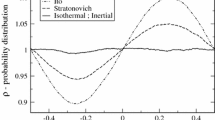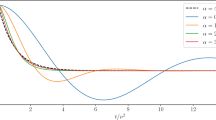Abstract
We investigate a class of nonequilibrium media described by Langevin dynamics that satisfies the local detailed balance. For the effective dynamics of a probe immersed in the medium, we derive an inequality that bounds the violation of the second fluctuation-dissipation relation (FDR). We also discuss the validity of the effective dynamics. In particular, we show that the effective dynamics obtained from nonequilibrium linear response theory is consistent with that obtained from a singular perturbation method. As an example of these results, we propose a simple model for a nonequilibrium medium in which the particles are subjected to potentials that switch stochastically. For this model, we show that the second FDR is recovered in the fast switching limit, although the particles are out of equilibrium.
Similar content being viewed by others
Data availability:
Data sharing not applicable to this article as no datasets were generated or analysed during the current study.
References
Kubo, R.: The fluctuation-dissipation theorem. Rep. Prog. Phys. 29(1), 255 (1966)
Kubo, R., Toda, M., Hashitsume, N.: Statistical Physics II: Nonequilibrium Statistical Mechanics, vol. 31. Springer, Berlin (2012)
Harada, T.: Phenomenological energetics for molecular motors. Europhys. Lett. 70(1), 49 (2005)
Harada, T., Sasa, Si.: Equality Connecting energy dissipation with a violation of the fluctuation-response relation. Phys. Rev. Lett. 95(13), 130602 (2005)
Harada, T., Sasa, Si.: Energy dissipation and violation of the fluctuation-response relation in nonequilibrium Langevin systems. Phys. Rev. E 73(2), 026131 (2006)
Harada, T., Sasa, Si.: Fluctuations, responses and energetics of molecular motors. Math. Biosci. 207(2), 365–386 (2007)
Cugliandolo, L.F., Dean, D.S., Kurchan, J.: Fluctuation-dissipation theorems and entropy production in relaxational systems. Phys. Rev. Lett. 79(12), 2168 (1997)
Toyabe, S., Muneyuki, E.: Single molecule thermodynamics of ATP synthesis by F1-ATPase. New J. Phys. 17(1), 015008 (2015)
Ariga, T., Tomishige, M., Mizuno, D.: Nonequilibrium energetics of molecular motor kinesin. Phys. Rev. Lett. 121(21), 218101 (2018)
Matsumoto, T., Otsuki, M., Ooshida, T., Goto, S., Nakahara, A.: Response function of turbulence computed via fluctuation-response relation of a Langevin system with vanishing noise. Phys. Rev. E 89(6), 061002 (2014)
Matsumoto, T., Otsuki, M., Ooshida, T., Goto, S.: Correlation function and linear response function of homogeneous isotropic turbulence in the Eulerian and Lagrangian coordinates. J. Fluid Mech. 919, A9 (2021)
Maes, C.: On the Second Fluctuation-Dissipation Theorem for Nonequilibrium Baths. J. Stat. Phys. 154(3), 705–722 (2014)
Hayashi, K., Sasa, Si.: Linear response theory in stochastic many-body systems revisited. Physica A 370(2), 407–429 (2006)
Maes, C., Safaverdi, S., Visco, P., Van Wijland, F.: Fluctuation-response relations for nonequilibrium diffusions with memory. Phys. Rev. E 87(2), 022125 (2013)
Maes, C.: Response theory: a trajectory-based approach. Front. Phys. 8, 229 (2020)
Maes, C.: Local detailed balance. SciPost Phys. p. 32 (2021)
Mizuno, D., Tardin, C., Schmidt, C.F., MacKintosh, F.C.: Nonequilibrium mechanics of active cytoskeletal networks. Science 315(5810), 370–373 (2007)
Nishizawa, K., Bremerich, M., Ayade, H., Schmidt, C.F., Ariga, T., Mizuno, D.: Feedback-tracking microrheology in living cells. Sci. Adv. 3(9), e1700318 (2017)
Jee, A.Y., Cho, Y.K., Granick, S., Tlusty, T.: Catalytic enzymes are active matter. Proc. Natl. Acad. Sci. U.S.A. 115(46), E10812–E10821 (2018)
Ross, J.L.: The dark matter of biology. Biophys. J. 111(5), 909–916 (2016)
Ariga, T., Tateishi, K., Tomishige, M., Mizuno, D.: Noise-induced acceleration of single molecule kinesin-1. Phys. Rev. Lett. 127(17), 178101 (2021)
Hayashi, K., Sasa, Si.: The law of action and reaction for the effective force in a non-equilibrium colloidal system. J. Phys. 18(10), 2825 (2006)
Maes, C., Steffenoni, S.: Friction and noise for a probe in a nonequilibrium fluid. Phys. Rev. E 91(2), 022128 (2015)
Haga, T.: Nonequilibrium Langevin equation and effective temperature for particle interacting with spatially extended environment. J. Stat. Phys. 159(3), 713–729 (2015)
Steffenoni, S., Kroy, K., Falasco, G.: Interacting Brownian dynamics in a nonequilibrium particle bath. Phys. Rev. E 94(6), 062139 (2016)
Maes, C., Thiery, T.: The induced motion of a probe coupled to a bath with random resettings. J. Phys. A 50(41), 415001 (2017)
Baiesi, M., Maes, C., Wynants, B.: Fluctuations and Response of Nonequilibrium States. Phys. Rev. Lett. 103(1), 010602 (2009)
Baiesi, M., Maes, C., Wynants, B.: Nonequilibrium linear response for markov dynamics, I: jump processes and overdamped diffusions. J. Stat. Phys. 137(5), 1094–1116 (2009)
Baiesi, M., Maes, C.: An update on the nonequilibrium linear response. New J. Phys. 15(1), 013004 (2013)
Maes, C.: Fluctuating motion in an active environment. Phys. Rev. Lett. 125(20), 208001 (2020)
Toyabe, S., Jiang, H.R., Nakamura, T., Murayama, Y., Sano, M.: Experimental test of a new equality: measuring heat dissipation in an optically driven colloidal system. Phys. Rev. E 75(1), 011122 (2007)
Dieterich, E., Camunas-Soler, J., Ribezzi-Crivellari, M., Seifert, U., Ritort, F.: Single-molecule measurement of the effective temperature in non-equilibrium steady states. Nat. Phys. 11(11), 971–977 (2015)
Wang, S.W., Kawaguchi, K., Sasa, Si., Tang, L.H.: Entropy production of nanosystems with time scale separation. Phys. Rev. Lett. 117(7), 070601 (2016)
Celani, A., Bo, S., Eichhorn, R., Aurell, E.: Anomalous thermodynamics at the microscale. Phys. Rev. Lett. 109(26), 260603 (2012)
Kawaguchi, K., Nakayama, Y.: Fluctuation theorem for hidden entropy production. Phys. Rev. E 88(2), 022147 (2013)
Zwanzig, R.: Nonlinear generalized Langevin equations. J. Stat. Phys. 9(3), 215–220 (1973)
Zwanzig, R.: Nonequilibrium Statistical Mechanics. Oxford University Press, Oxford (2001)
Girsanov, I.V.: On transforming a certain class of stochastic processes by absolutely continuous substitution of measures. Theory Probab. Appl. 5(3), 285–301 (1960)
Gardiner, C.W.: Handbook of Stochastic Methods, 4th edn. Springer, Berlin (2009)
Maes, C.: Frenesy: time-symmetric dynamical activity in nonequilibria. Phys. Rep. 850, 1–33 (2020)
Risken, H.: The Fokker-Planck Equation. Springer, Berlin (1996)
Seifert, U., Speck, T.: Fluctuation-dissipation theorem in nonequilibrium steady states. Europhys. Lett. 89(1), 10007 (2010)
Seifert, U.: Entropy production along a stochastic trajectory and an integral fluctuation theorem. Phys. Rev. Lett. 95(4), 040602 (2005)
Sekimoto, K.: Stochastic Energetics. Springer, New York (2010)
Seifert, U.: Stochastic thermodynamics, fluctuation theorems and molecular machines. Rep. Prog. Phys. 75(12), 126001 (2012)
Zwanzig, R., Nordholm, K., Mitchell, W.: Memory effects in irreversible thermodynamics: corrected derivation of transport equations. Phys. Rev. A 5(6), 2680 (1972)
Sture, K., Nordholm, J., Zwanzig, R.: Strategies for fluctuation renormalization in nonlinear transport theory. J. Stat. Phys. 11(2), 143–158 (1974)
Mori, H., Fujisaka, H.: On nonlinear dynamics of fluctuations. Prog. Theor. Phys. 49(3), 764–775 (1973)
Kawasaki, K.: Simple derivations of generalized linear and nonlinear Langevin equations. J. Phys. A 6(9), 1289 (1973)
Fujisaka, H.: Fluctuation renormalization in nonlinear dynamics. Prog. Theor. Phys. 55(2), 430–437 (1976)
Granek, O., Kafri, Y., Tailleur, J.: The Anomalous Transport of Tracers in Active Baths. arXiv preprint arXiv:2108.11970 (2021)
Alder, B.J., Wainwright, T.E.: Decay of the velocity autocorrelation function. Phys. Rev. A 1(1), 18 (1970)
Pomeau, Y., Resibois, P.: Time dependent correlation functions and mode-mode coupling theories. Phys. Rep. 19(2), 63–139 (1975)
Huang, R., Chavez, I., Taute, K.M., Lukić, B., Jeney, S., Raizen, M.G., Florin, E.L.: Direct observation of the full transition from ballistic to diffusive Brownian motion in a liquid. Nat. Phys. 7(7), 576–580 (2011)
Franosch, T., Grimm, M., Belushkin, M., Mor, F.M., Foffi, G., Forró, L., Jeney, S.: Resonances arising from hydrodynamic memory in Brownian motion. Nature 478(7367), 85–88 (2011)
Kheifets, S., Simha, A., Melin, K., Li, T., Raizen, M.G.: Observation of Brownian motion in liquids at short times: instantaneous velocity and memory loss. Science 343(6178), 1493–1496 (2014)
Zwanzig, R.: Memory effects in irreversible thermodynamics. Phys. Rev. 124(4), 983 (1961)
Saito, K., Hongo, M., Dhar, A., Sasa, Si.: Microscopic theory of fluctuating hydrodynamics in nonlinear lattices. Phys. Rev. Lett. 127(1), 010601 (2021)
D’Alessio, L., Kafri, Y., Polkovnikov, A.: Negative mass corrections in a dissipative stochastic environment. J. Stat. Mech. 2016(2), 023105 (2016)
Weinberg, P., Bukov, M., D’Alessio, L., Polkovnikov, A., Vajna, S., Kolodrubetz, M.: Adiabatic perturbation theory and geometry of periodically-driven systems. Phys. Rep. 688, 1–35 (2017)
Feng, M., Hou, Z.: Effective dynamics of tracer in active bath: A mean-field theory study. arXiv preprint arXiv:2110.00279 (2021)
Nakayama, Y., Kawaguchi, K., Nakagawa, N.: Unattainability of Carnot efficiency in thermal motors: coarse graining and entropy production of Feynman-Smoluchowski ratchets. Phys. Rev. E 98(2), 022102 (2018)
Tailleur, J., Cates, M.E.: Statistical mechanics of interacting run-and-tumble bacteria. Phys. Rev. Lett. 100(21), 218103 (2008)
Cover, T.M., Thomas, J.A.: Elements of Information Theory, 2nd edn. Wiley-Interscience, Hoboken, NJ (2006)
Martin, D., O’Byrne, J., Cates, M.E., Fodor, É., Nardini, C., Tailleur, J., van Wijland, F.: Statistical mechanics of active Ornstein-Uhlenbeck particles. Phys. Rev. E 103(3), 032607 (2021)
Acknowledgements
The author thanks Ken Hiura for helpful discussions on the singular perturbation method. The author also thanks Shin-ichi Sasa for valuable comments throughout the manuscript. The present study was supported by JSPS KAKENHI Grant No. 20J20079, a Grant-in-Aid for JSPS Fellows.
Author information
Authors and Affiliations
Corresponding author
Additional information
Communicated by Hal Tasaki.
Publisher's Note
Springer Nature remains neutral with regard to jurisdictional claims in published maps and institutional affiliations.
Appendices
Appendix A: Derivation of the Effective Dynamics for the Potential Switching Medium
Excess Action
We first confirm that, to first order in \(X_s-X_t\), the excess action \({\mathcal {A}}([{{\varvec{x}}},{{\varvec{\sigma }}}]|[X]))\) is given by
with the backward operator for the dynamics (80) with \(X_t\) held fixed:
To this end, we calculate \({\mathbb {P}}([{{\varvec{x}}},{{\varvec{\sigma }}}]|[X])\) and \({\mathbb {P}}([{{\varvec{x}}},{{\varvec{\sigma }}}]|X_t)\). We first consider a trajectory in the time interval [0, t] and discretized time \(t_n=n\varDelta t\in [0,t]\) (\(n=0,1,\cdots ,M\)) with \(t\equiv M\varDelta t\). Correspondingly, let \([{{\varvec{x}}},{{\varvec{\sigma }}}]:=\{({{\varvec{x}}}_0,{{\varvec{\sigma }}}_0),({{\varvec{x}}}_1,{{\varvec{\sigma }}}_1),\cdots ,({{\varvec{x}}}_M,{{\varvec{\sigma }}}_M)\}\) be the discretized trajectory, where \(({{\varvec{x}}}_n,{{\varvec{\sigma }}}_n):=({{\varvec{x}}}_{t_n},{{\varvec{\sigma }}}_{t_n})\). Suppose that the state \(\sigma ^j\) is switched at time intervals with \(n=n^j_1,n^j_2,\cdots ,n^j_{k_j}\in \{0,1,\cdots ,M\}\) as
We denote by \(\varSigma ^j_\ell \in \{0,1\}\) the value of \(\sigma ^j_n\) for \(n^j_\ell <n\le n^j_{\ell +1}\) with \(n^j_0:=-1\) and \(n^j_{k_j+1}:=M\). For notational simplicity, we rewrite (80) as
where \(U_1(x^j,\sigma ^j):=\kappa _b(x^j-\sigma ^jL)^2/2\), \(V_1(x^j,X):=\kappa _c(x^j-X)^2/2\), and the prime denotes the derivative with respect to \(x^j_t\). In the second line, we have introduced a time-dependent amplitude \(h_s:=X_s-X_t\) and \(f(x^j_s):=\partial _j\varPhi ({{\varvec{x}}}_s,X_t)=\lambda \kappa _c\) to explicitly represent the deviation from the dynamics with \(X_t\) held fixed. Then, the probability density of a trajectory \({\mathbb {P}}([{{\varvec{x}}},{{\varvec{\sigma }}}]|[X])\) starting from \(({{\varvec{x}}}_0,{{\varvec{\sigma }}}_0)\) reads [6]
Here, \({\bar{x}}^j_n:=(x^j_{n+1}+x^j_n)/2\) and \({\bar{h}}_n:=(h_{n+1}+h_n)/2\). We note that \({\mathbb {P}}([{{\varvec{x}}},{{\varvec{\sigma }}}]|X_t)\) is immediately obtained from (A.5) by setting \({\bar{h}}_n=0\). From these expressions, it follows that
By taking the continuum limit and replacing the time interval from [0, t] to \([-\infty ,t]\), we obtain the excess action \({\mathcal {A}}([{{\varvec{x}}},{{\varvec{\sigma }}}]|[X])\):
where
1.1 Explicit Calculation of \(G(X_t)\), \(\gamma (t-s)\), and \(\gamma _{\mathrm {ex}}(t-s)\)
Here, we calculate \(G(X_t)\), \(\gamma (t-s)\), and \(\gamma _{\mathrm {ex}}(t-s)\) explicitly. The starting point is the stationary solution of (80) with \(X_t\) held fixed (93):
The statistical force is immediately obtained by substituting (A.9) into its definition:
To calculate the friction kernel, we first calculate the response function \(R_{\varPhi \varPhi }(t-s)\). The response function \(R_{\varPhi \varPhi }(t-s)\) is expressed as
By using (A.9) and the relation
\(\langle x^i_s;x^j_t\rangle ^{X_t}\) and \(\langle \sigma ^i_s;x^j_t\rangle ^{X_t}\) are calculated as
Therefore, for \(t\ge s\), the response function is
From this result, it follows that
To obtain the explicit expression of \(\gamma _{\mathrm {ex}}(t-s)\), we calculate the noise correlation \(\langle \eta _t\eta _s\rangle ^{X_t}\). By using (A.12), the noise correlation is calculated as
Thus, the excess friction kernel \(\gamma _{\mathrm {ex}}(t-s)\) is given by
Rights and permissions
About this article
Cite this article
Tanogami, T. Violation of the Second Fluctuation-dissipation Relation and Entropy Production in Nonequilibrium Medium. J Stat Phys 187, 25 (2022). https://doi.org/10.1007/s10955-022-02921-7
Received:
Accepted:
Published:
DOI: https://doi.org/10.1007/s10955-022-02921-7




